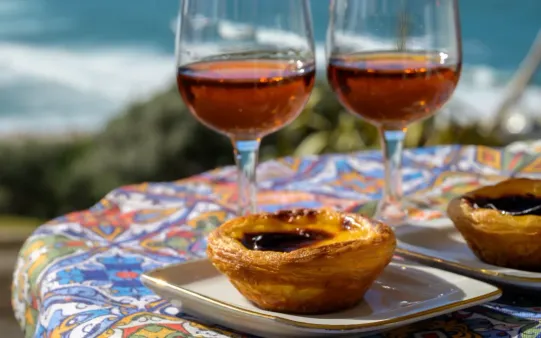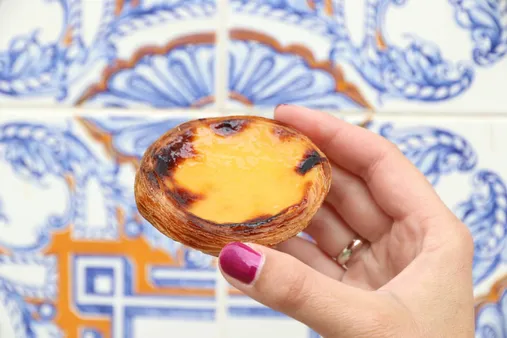Table of Contents
Welcome to tauhuichiban, where we explore the delightful world of nata portuguese tart. This scrumptious dessert has captured hearts and taste buds worldwide with its creamy custard filling and flaky pastry crust. In this article, we'll delve into the fascinating history of this iconic treat, share a simple recipe for making it at home, and discover where you can savor it across the globe.
Key Takeaways from Our Article on Nata Portuguese Tart | |
|---|---|
#1: | Learn about the origins of Nata Portuguese Tart in Lisbon's Jerónimos Monastery. |
#2: | Follow our step-by-step guide to create your own mouthwatering version at home. |
#3: | Discover popular spots worldwide where you can enjoy authentic Pastéis de Nata. |

The Ultimate Guide To Nata Portuguese Tart
Nata Portuguese Tart: A Delicious History
The Birth of a Classic
Imagine a world where monks used egg whites to starch their clothes, leaving behind a treasure trove of egg yolks. This curious scenario played out in the 18th century at the Jerónimos Monastery in Lisbon, Portugal, where the nata portuguese tart was born.
Year | Event |
|---|---|
1820 | Liberal Revolution of 1820 |
1837 | Fábrica de Pastéis de Belém opens |
A Recipe Born of Necessity
The monks, faced with an abundance of egg yolks, created a recipe that would become a Portuguese staple. They mixed the yolks with sugar, milk, and other ingredients, then poured the mixture into flaky pastry cups and baked them to perfection. The result was a sweet, creamy, and utterly delicious treat.
- Original recipe remains a closely guarded secret
- Fábrica de Pastéis de Belém is the only place that makes the original Pastéis de Belém
A Global Phenomenon
Today, the nata portuguese tart is enjoyed worldwide, with variations popping up in bakeries and cafes from Macau to Madrid. Its popularity has earned it a spot on The Guardian's list of the "50 best things to eat in the world" and recognition as one of Portugal's Seven Wonders of Gastronomy.

Nata Portuguese Tart: A Delicious History
How to Make Nata Portuguese Tart at Home
Making nata portuguese tart at home is easier than you think! With a few simple ingredients and some basic kitchen equipment, you can create this delicious Portuguese dessert in the comfort of your own home.
The first step is to make the pastry dough. You'll need flour, butter, and water to create a flaky and crispy crust. Once you've mixed the ingredients together, knead the dough until it's smooth and pliable.
Ingredient | Quantity |
|---|---|
Flour | 2 cups |
Butter | 1/2 cup |
Water | 1/4 cup |
Next, you'll need to prepare the custard filling. This involves mixing together egg yolks, sugar, and milk to create a creamy and sweet filling. Be sure to cook the mixture over low heat, stirring constantly, until it thickens.
- Egg yolks: 4-6
- Sugar: 1 cup
- Milk: 1 cup
Once you've prepared the pastry dough and custard filling, it's time to assemble the tarts. Simply roll out the dough, place a spoonful of custard in the center, and fold the dough over to create a triangle. Brush the tops with egg wash and bake until golden brown.
Enjoying Nata Portuguese Tart Around the World
As I sit here, sipping on a warm cup of coffee and indulging in a flaky, creamy nata portuguese tart, I am reminded of the power of food to bring people together.
A Global Phenomenon
The nata portuguese tart has become a staple in bakeries and cafes around the world, from Macau to Madrid. Its popularity has earned it a spot on The Guardian's list of the "50 best things to eat in the world" and recognition as one of Portugal's Seven Wonders of Gastronomy.
City | Popular Nata Portuguese Tart Spots |
|---|---|
Macau | Lord Stow's Bakery, Margaret's Café e Nata |
Madrid | Pastelería Mallorca, El Riojano |
Local Flavors and Twists
As the nata portuguese tart has traveled the world, local flavors and twists have emerged, making each region's version unique and delicious in its own right.
- In Macau, the tart is often served with a side of coffee or tea.
- In Madrid, a sprinkle of cinnamon is added on top of the tart.
- In Lisbon, the original recipe remains a closely guarded secret.

Enjoying Nata Portuguese Tart Around the World
Final Thought
The Nata Portuguese Tart is more than just a dessert; it's a symbol of culinary heritage that continues to enchant people around the world. By understanding its history and mastering the art of making these tarts at home, you can bring a piece of Portugal into your kitchen. So go ahead, indulge in this delectable treat and share it with friends and family for an unforgettable experience.